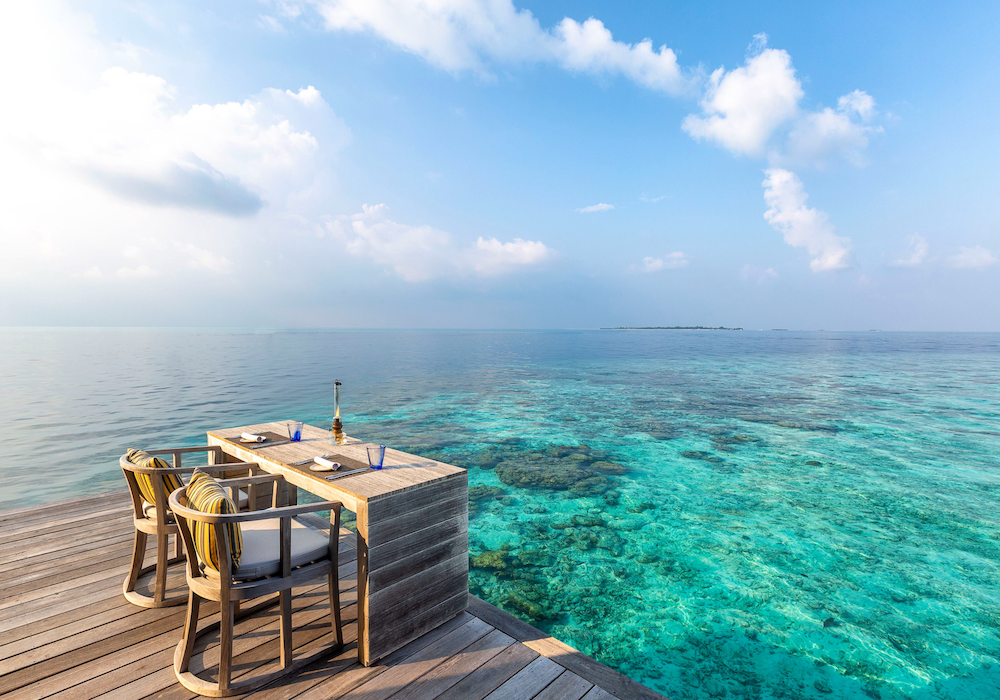It had been a long 12 months since I’d flown back to the UK from Vermont. I left behind perfect February piste conditions in Sugarbush and Stratton, safe in the knowledge that this was only my season opener. There were plans to see Trentino again, and perhaps visit Norbert Niederkofler at St. Hubertus. I even skipped out early on the final mountain day, putting in a morning-only session. Sacrilegious.
If it had been a year since I’d set foot on powder, how long since I’d felt the sand beneath my feet and the sun upon my face? I used to consider the archetypal beach holiday a close second to an active winter in the mountains. How could I possibly sit motionless on a beach, with nothing to distract me from the world rapidly spinning on its axis but exceptionally high-grade cocktails and my own internal dialogue? But then the azure views and incredible proximity to the natural world call to you. With age, we hope, comes some wisdom and the ability to be still and take in one’s surroundings without ADHD medication. Or at least to be mindful of the need to rest and recuperate properly. It would take a certain calibre of a resort to see me relent and reset my mindset to island-time on Hurawalhi.
READ THE FEATURE HERE IN THE MAURO COLAGRECO EDITION
To say Terminal 5 was quiet would be a dramatic understatement. I don’t particularly enjoy the airport process unless there is a private terminal involved. I appreciate that makes me sound a little elitist, but no one can honestly say they enjoy passport security and baggage drop off. I find flight incredible, whether it’s aboard a Sikorsky S-76 or a Bombardier Challenger 850. But no one relishes standing in line with the rampant hordes. The only elements that make it mildly bearable are prescription-grade narcotics and not having to queue two metres apart. Total Heathrow passengers in February 2020 totalled 5.4 million. That figure was down 91% in February 2021 to 461,000. Mile after mile of empty seats really is my kind of speed. It seemed the only requirement for travel was that we submit a negative PCR test. We took ours with Concierge Medical Practice, an award winning private GP service that still makes house calls. Our British Airways flight had 56 souls on board, total. After over a year of being confined to quarters, the people watching, albeit rather vanilla, was profound.
We touched down ten-and-a-half hours later in the Maldivian capital of Malé in 32-degree heat. I already felt galaxies apart from life in the UK. The Hurawalhi team of airport fixers are certainly deft when it comes to transfers. Once we’d made it through passport control, we were checked onto our connecting seaplane and into our transfer to the terminal in less than 10 minutes. As far as post flight operations go, it was certainly polished.
Seaplane is one of the most spectacular ways to arrive at Hurawalhi. The de Havilland Twin Otter is unpressurised and a rite of passage for anyone travelling to the 1190-island archipelago of the Maldives. The journey to the Lhaviyani Atoll takes around 40 minutes – enough time to either power-nap or stare intently out of the window at the blueprint of the original 90s desktop background.
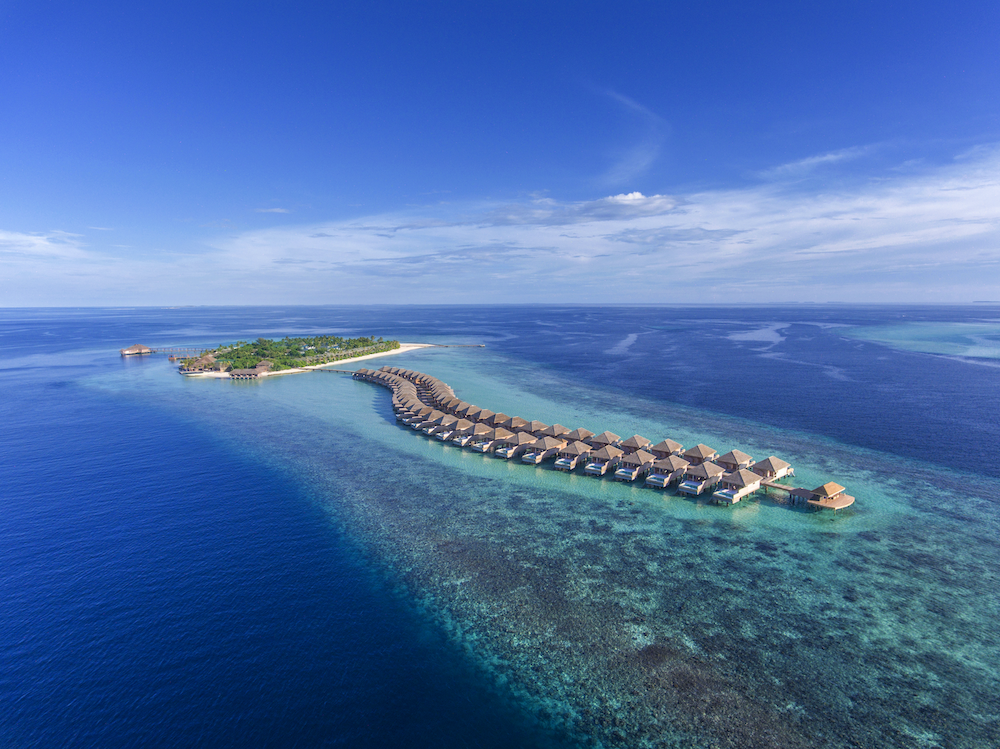
Hurawalhi island is 400 metres long and one of the few Maldivian islands without a myriad of other resorts on the immediate horizon. The property has 90 villas in total: 60 over water and 30 dotted around the beaches of the island. It’s also distinctly adults-only, and whilst many people would now feign a deep adoration for children, I shan’t. Downtime is downtime, and I like my moments of zen to involve a soundtrack of my choosing.
On arrival we were greeted by a fanfare of traditional Maldivian drums lining the jetty walkway known as Bodu Beru. This was perhaps the largest group of people I had seen in close proximity for 12 months and the general sense of joy was infectious. The resort’s architectural mastermind is the renowned Yuji Yamazaki of YYA New York. The first design element to strike me was the vaulted ceilings in the welcome pavilion that feature a sculpture of a huge swarm of bait fish suspended over a weeping black-stone. Maldivian and Japanese iconography working in synergy. The communal areas are all incredibly elegant and calming spaces, providing respite from the midday heat.
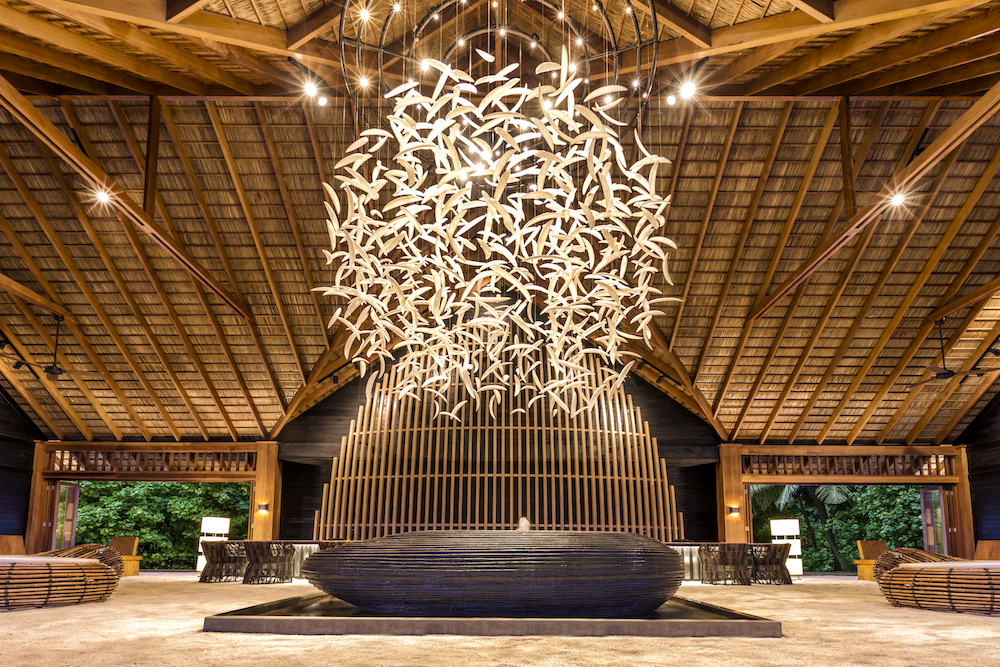
With the sun beating down, we were introduced to our butler, Rafa, who kindly showed us to our over water villa and ensured we had changed our watches to island-time. In short, the island put its clocks forward an hour to allow guests to get more done in daylight. The main bulk of the resort’s accommodation is set on an idyllic walkway that snakes out over the ocean. It’s crowning glory, a chic pavilion located at the very tip, offering champagne and canapes alongside Maldivian sunsets. Kashmir is also always on hand to guide you in pursuit of the perfect bottle.
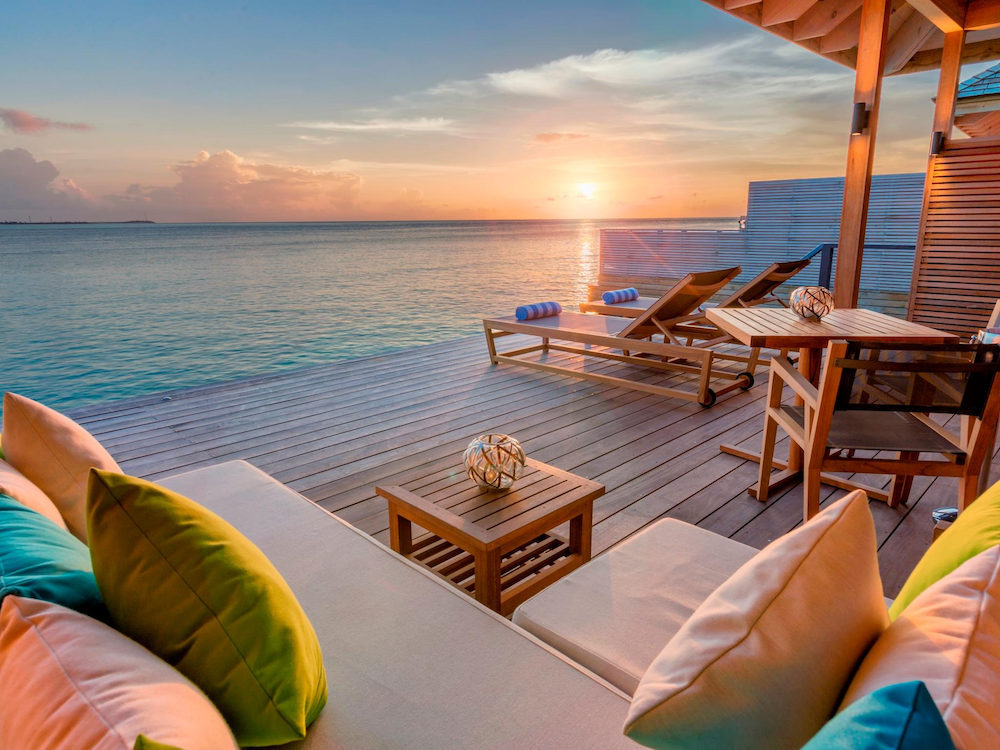
The villas take a minimal and modernist approach to conventional Maldivian design. Each has the usual conveniences, along with a separate indoor and outdoor seating area, wine fridge, outdoor sundeck with infinity pool and, of course, a long set of stairs down to the ocean. The crowning glory is perhaps the sliding door out from the bathroom, next to the rain shower, proving a truly one-of-a-kind view. Every seated area within the property benefitted from having an ocean view out across the pool to the cobalt hued vista. Of course, each property has a smart TV, sizable selection of movies and bluetooth soundbar. To a certain extent, I can see why guests might want to watch TV in bed at night or the news in the morning over coffee. But if you’re not out there on the island soaking up every morsel of the experience, you’ll kick yourself – unless I can find you first.
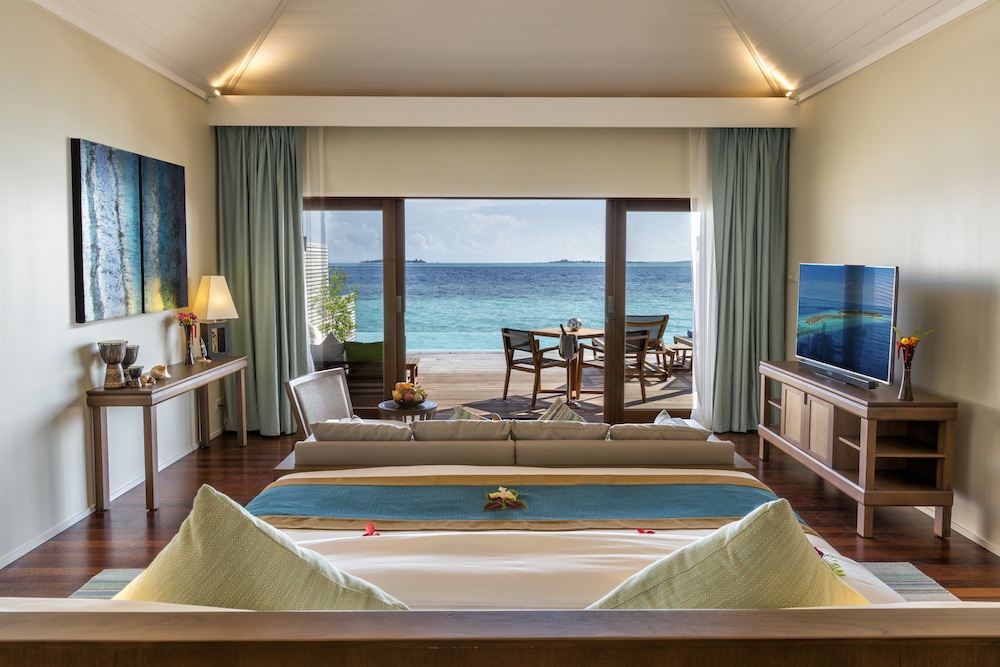
With a few hours to kill until our sunset outing, I took the opportunity to snorkel out across the flats. After 24-plus hours in transit and 12 months in lockdown, stepping out into the Indian Ocean felt exceptional. Having swum out to the drop off, I realised when I turned that I could no longer designate my villa from any of the 30-something others. Luckily, each has a small plaque detailing the number, otherwise I would have appeared on a honeymooning couples balcony holding a pair of flippers, dripping wet. As the sun began to set, we packed away the snorkelling gear and made our way to the island’s jetty for sundowners aboard one of the resort’s many boats.
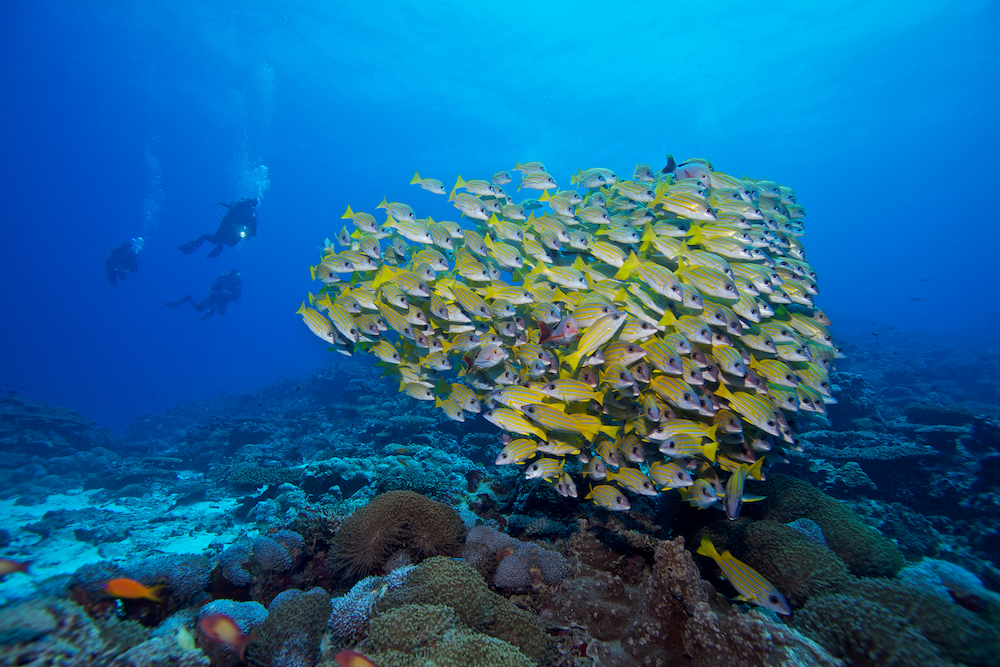
The stroll from the villa to the main island across the stilted walkway was a close second to snorkeling 500 metres to the beach. The wooden path eventually gives way to manicured tunnels of foliage that twist and turn around the small island in Lewis Carroll fashion. I wondered why they didn’t opt to provide each villa with push-bikes to save ferrying people in buggies? Though I would give it a week before people were swerving off the walkway into the shallow waters below.
The abundance of sealife in the Lhaviyani Atoll is a testament to the island’s sustainability practices and ongoing conservation programmes. Our evening sunset cruise and dolphin safari was punctuated by the captain and crew pointing out pods of spinner dolphins off the bow. There are almost a dozen species of dolphin in the region, and many of the spinner dolphins can be spotted as near as the house reef over dinner. Though I do recommend heading out with the crew and sitting on the top deck, glass in hand, watching these majestic creatures up close.
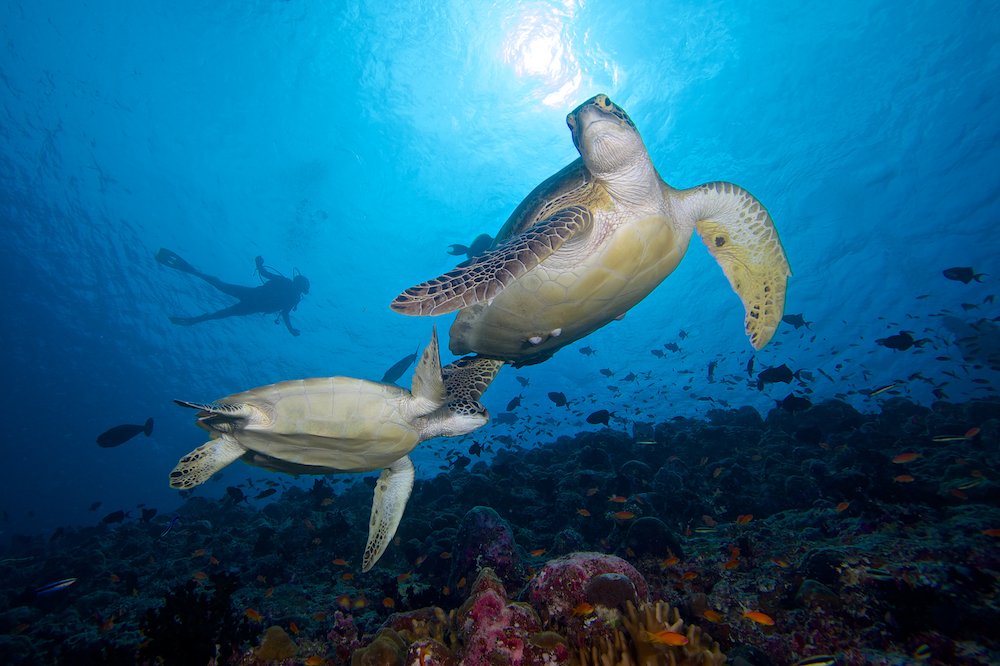
Indeed, get thoroughly stuck into the conservation programme with Lara, the resident marine biologist. The island’s Marine Biology Centre was set up together with Prodivers Maldives and Manta Trust. The dive team balances their time between diving and snorkelling excursions and rebuilding coral nurseries alongside several key conservation programmes. Book in for a snorkelling trip on the house reef with Lara when you touch down. She took us on an incredible journey around the island, pointing out reef sharks, eagle rays and just some of the 200 species of coral. The shallow channels around the island are also home to a manta ray population of some 300, with sightings frequently occurring.
Rafa, our charming butler, was always on hand to offer advice on snorkelling spots, dinner requests, and to let us know if something mythical had been spotted offshore.
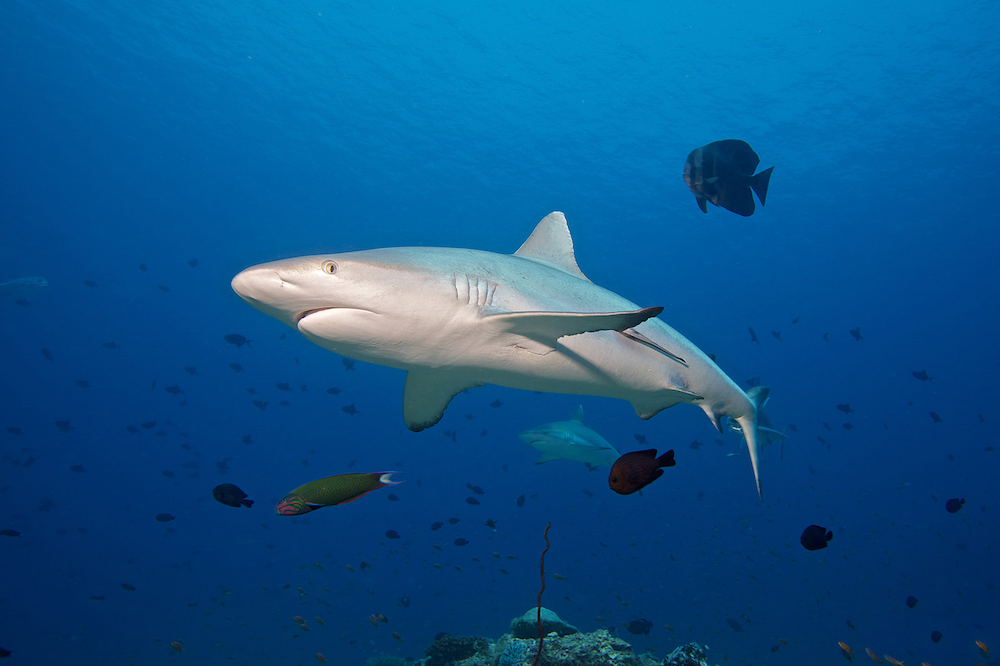
After a relatively busy day of island life, my appetite was beginning to return, having been sedated by a myriad of in-flight snacks. In addition, lockdown had meant I hadn’t sat in a restaurant since October, so by this point craved that element of normality.
The island benefits from four main restaurants. Canneli is the resort’s main buffet-style eatery, offering a variety of freshly cooked dishes from around the globe. Many of these are prepared and served at live cooking stations. If you try one thing at dinner, have the Maldivian fish curry. You will remain eternally spoiled for choice, regardless – and despite my best efforts, I still didn’t try everything I wanted on the menu in three days. The restaurant itself sits on the island’s northerly edge, so breakfast, lunch and dinner all have the most incredible views, whether sat outside on the wraparound terrace or inside amongst the sweeping wooden architecture.
Junk Food Kitchen – JFK – speaks for itself, serving rather upscale favourites. Try the seared tuna ahi, confit duck nuggets, yellow fin tacos and vegan nachos. Again, I didn’t manage to try everything I wanted to, but then again, I don’t fancy a gastric band all that much. If I return, perhaps I’ll spend the days diving and the evenings adding ballast?
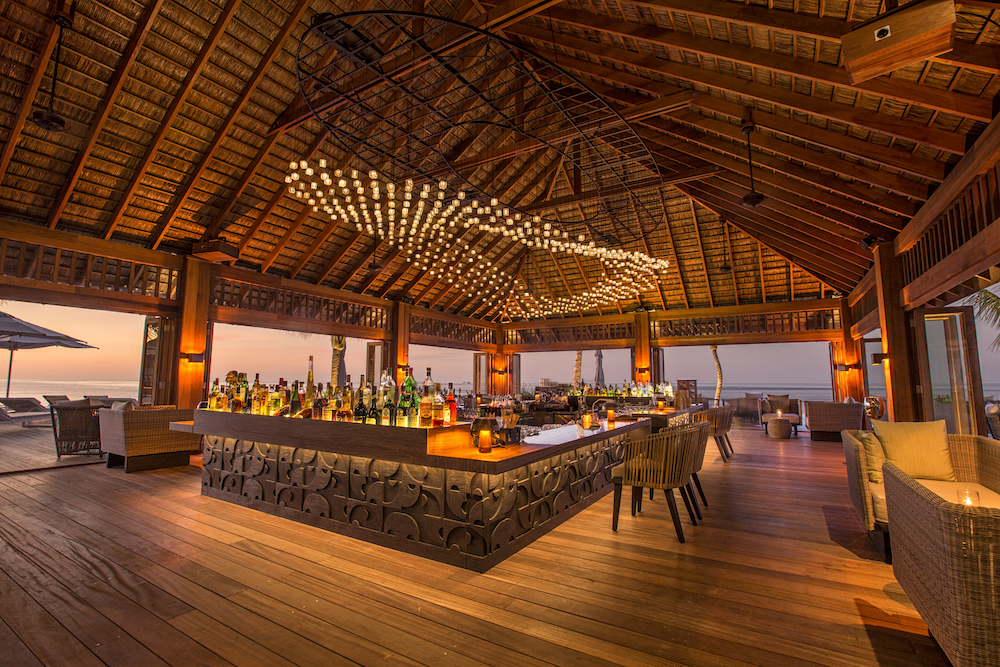
One of my firm favourites very quickly became Kashibo, Hurawalhi’s contemporary overwater restaurant serving incredible Asian cuisine. From fresh sushi to teppanyaki, the minimalist seating set up on the restaurant’s outer terrace leaves you entirely immersed in the ocean around you. Try the delicious soft shell crab, the world’s actual best prawn toast, a variety of the freshest sashimi and sushi, and the gulab jamun. It was my grandmother’s absolute favourite pudding. Make sure you order a selection of cocktails, starting with the lychee Martini and Thai sabai. If you order too late in your stay, you won’t have enough time to return day after day for afternoon cocktails or pre-dinner drinks, as they are sublime. I also found a particular barman (Mondy, in Kashibo) had probably the world’s most entertaining laugh. So I spent most of the time trying to get him into fits of laughter.
Hurawalhi’s jewel in the culinary crown is arguably that it has the world’s largest all-glass undersea restaurant called 5.8. No bonafide travel documentary or Maldives guide is likely to go without mentioning it at least twice. It’s single, 969-square feet of six-inch thick glass weighs in at 400 metric tons. It was constructed in New Zealand and shipped to the resort in one piece, taking over two years. It opened in 2016 and is still the largest underwater restaurant on the planet. It seats 10 couples across two lunch sittings and one dinner.
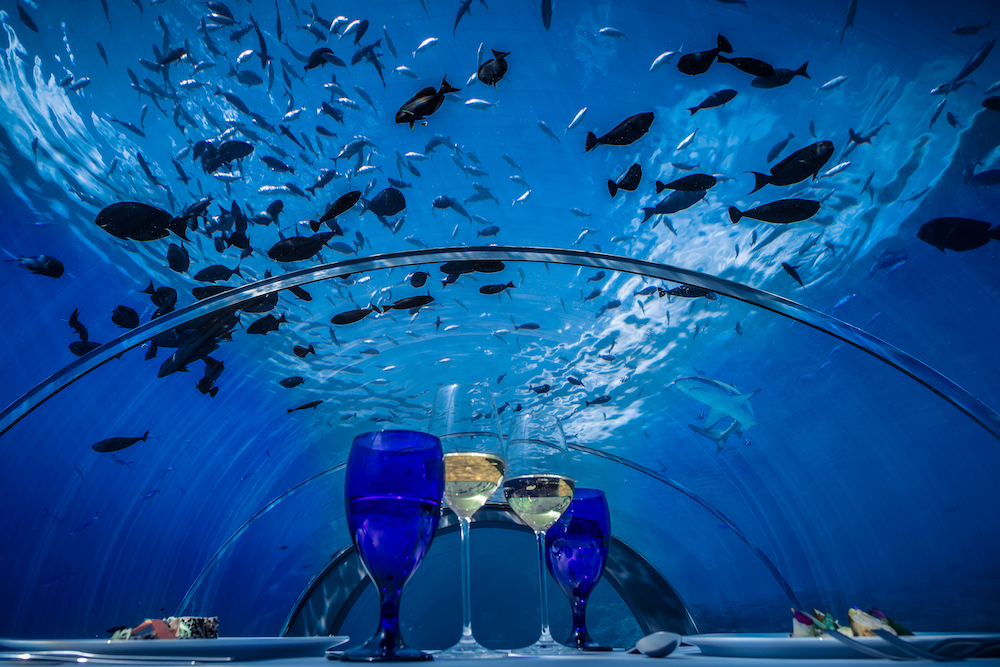
Outside the glass, the sustainability effort continues with continued programmes to rebuild and save more coral gardens near the resort’s house reef. You really get a clear idea of the engineering that goes into the conservation effort at almost six metres down.
You can also opt to do that without a glass of champagne and with flippers instead. The truly one-of-a-kind vista from beneath the water out onto Hurawalhi’s reef is fascinating. Not a course passes by without muted shrieks from fellow diners keen to point out the wonders of the ocean passing the glass. But don’t let this elaborate dinner-theatre setting fool you. It’s not a game of show, and it’s not a standalone party piece; the chef and the sommelier are not playing dress up. Executive chef Edouard Laurent Deplus was classically trained at the Paul Bocuse Institute in France and was at the company’s sister resort, Kudadoo Private Island, before making his mark on Hurawalhi.
With the kitchen team behind closed doors, the main face of the operation is Ramesh Kumar, the island’s sommelier. Ramesh cut his teeth and earned his credentials at the Mandarin Oriential and Intercontinental, and is perhaps one of the most personable and genuine human beings I’ve ever had the pleasure of meeting. Which surprises even me, considering I met this charming individual 5.8 metres under the sea, in effectively another world. Not to mention we were both barefoot. Well, everyone was barefoot. I am sure there is a good reason for it, and had I known beforehand, I would have walked to the restaurant without shoes entirely.
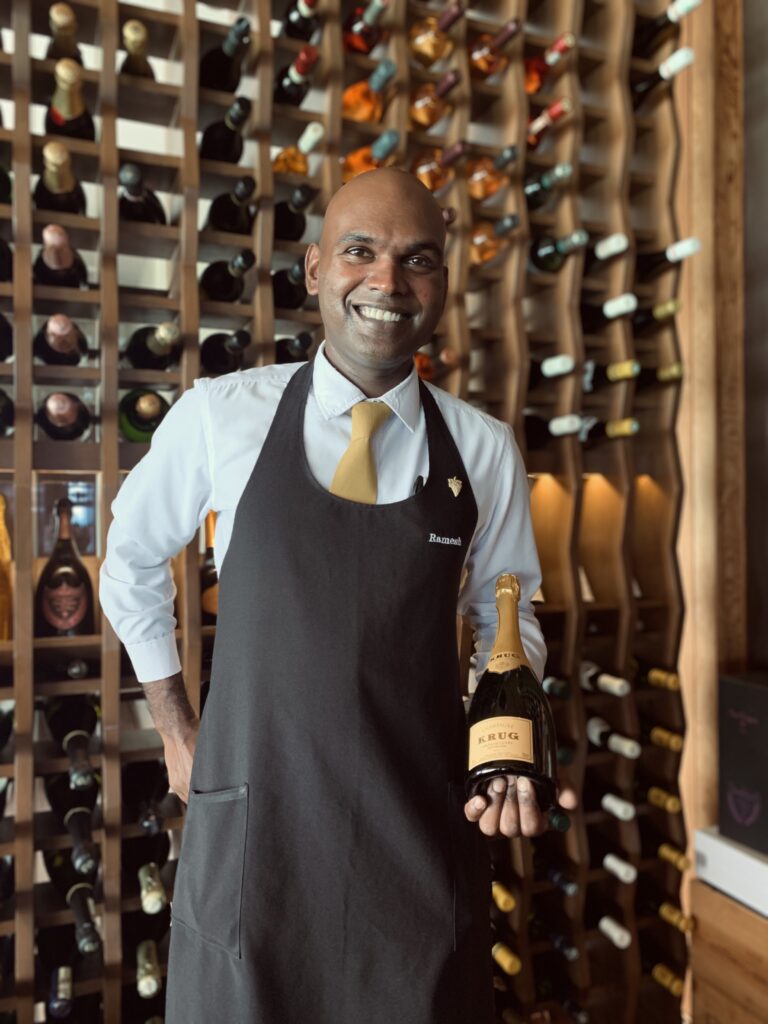
With a set, five-course lunch and wine pairing, you can look forward to an incredibly well-balanced tuna tartare with wasabi mayonnaise and Beluga caviar followed by ponzu salmon belly, aromatic glazed scallop, wasabi gel, squid ink crumble, dashi mustard and scallop ceviche. With food this exquisite and a view as encapsulating, I was glad to have Ramesh there to do the heavy lifting.
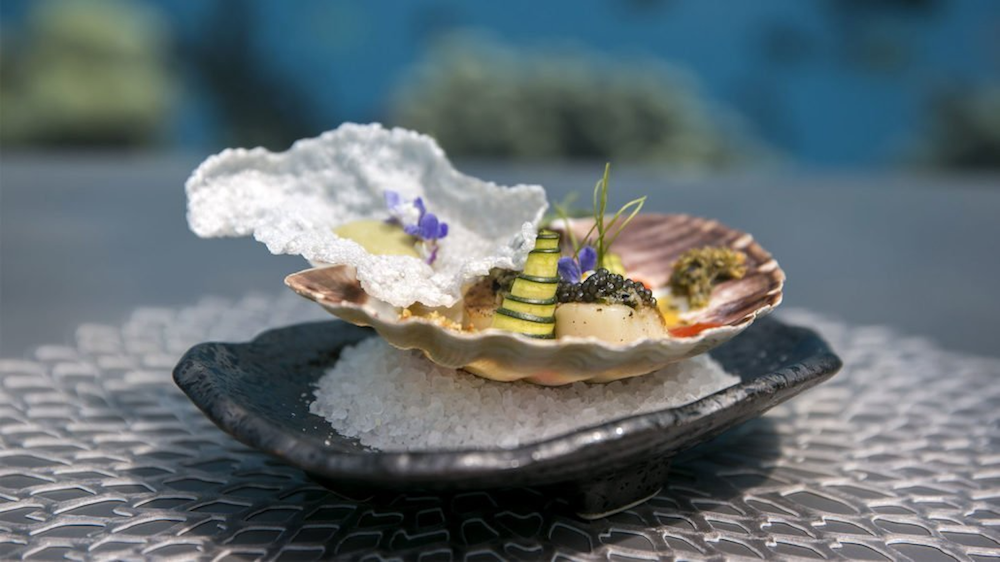
The first two dishes were paired with an untouchable Ferrari Perlé. This was followed by a 100 Hills riesling from Philipp Wittmann, one of the greatest German white wine producers, which really cut through the richness of the pan seared red mullet with saffron, turmeric and beluga coconut broth. Ramesh then moved us onto an oaked Chardonnay for the duo of lobster tails, which was a triumph. The seared wagyu tenderloin with cheek confit and duck confit pommes was paired with a Marques de Casa Concha from Chile, which really opened up the accompanying pickled cherry beet and truffle jus.
With a menu this heavy-hitting, I’m always intrigued by the chef’s dessert choice. In this case, it was a mango cheesecake with cocoa cracker soil, mango mousse and coconut ice cream. The Moscato d’Asti, though light, was incredibly fragrant and really intensified the syrup of the mango. The dishes themselves were ornately constructed, with a real effort to encapsulate the underwater world that the restaurant finds itself within 5.8, it’s kitchen team and Ramesh is a coup de maître in an already-enticing lineup of island eateries.
As you might expect, with dining options this varied and considered, I had to keep moving for fear of beaching. The island’s gym is a properly effective set up, with an array of machines and weights facing out onto the open ocean. A view is never sacrificed at Hurawalhi. If you’re looking for a group affair, you can join a yoga or bootcamp workout on the schedule. If I’d had the foresight and the body mass index, I might have headed out with the yoga instructor to ‘dream island’, an isolated and relatively untouched sand bar a few hundred metres offshore. You can also arrange a private lunch or dinner on the decidedly escapist encampment.
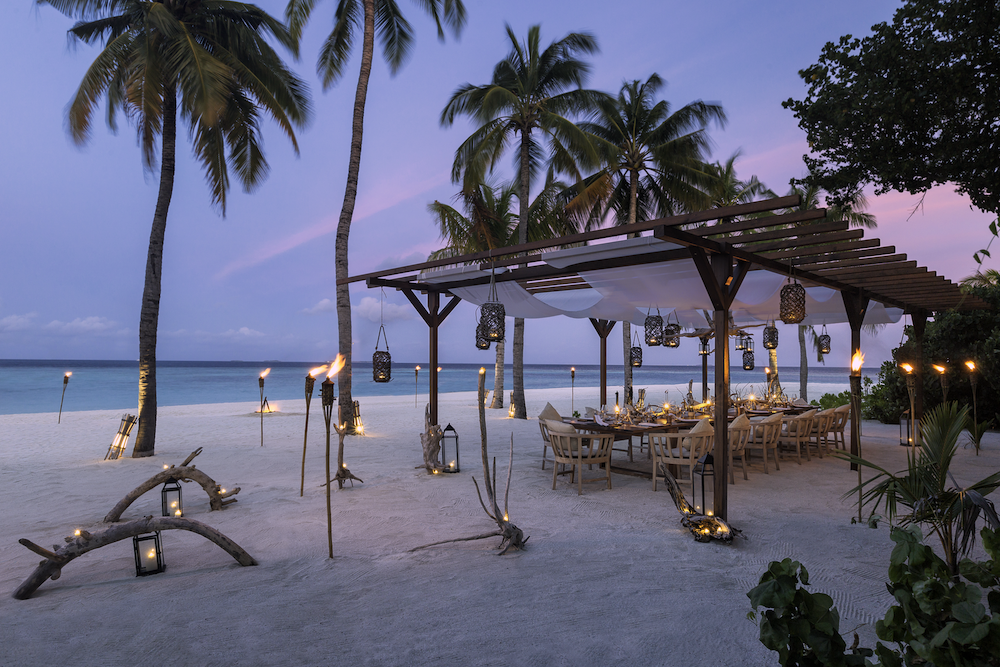
If the island sounds like a foodie sanctuary, there are equal measures of activities, including badminton, diving, jet skis, wakeboarding and windsurfing. Not to mention the island favourite, padel tennis. For a number of years, I have watched fly boarding off the coast of Antibes and wanted to try my hand at it. With more than a little trepidation, I headed out with watersports instructor Taichi. Even with a full briefing and safety gear, be aware, you’re heading up to 50 feet in the air if you’ve got the bottle. Falling in a semi-controlled fashion is still a fall. It requires a strong core and is certainly no time to have skipped leg day. Within a few minutes, I was hovering above the azure water, trying my best to emulate a stone column, as Taichi did his best to photograph me in full downward facing dolphin. Yes, I swallowed a decent amount of seawater and was totally and utterly spent after just a 30-minute session – but I would have done it again after a quick refuel at Kashibo, no questions asked.
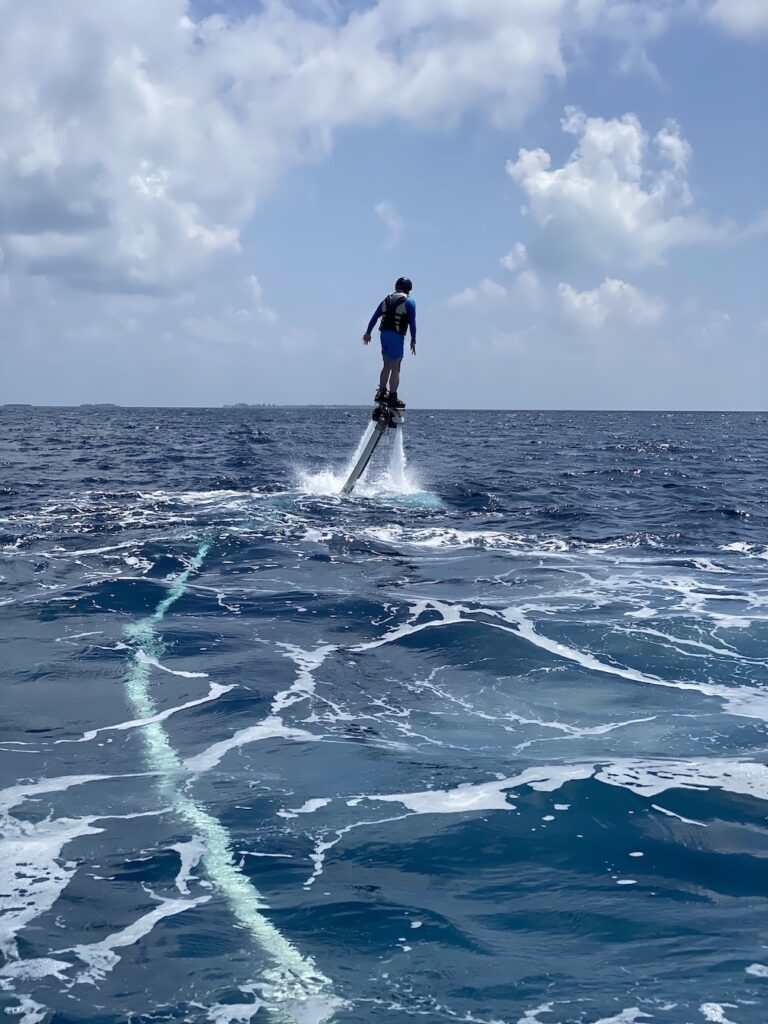
As the sun begins to set, so begins the habitual flight of the residents to the island’s champagne pavilion and resorts hub, Coco Bar. It’s an incredibly relaxed venue that’s floating light fixtures roll like a calm wave above the sea of bottles below it. I spent many a cocktail transfixed by its warm and inviting lights. Bar manager Lalith was always on hand to ensure my glass never ran dry and to talk about the Six Nations in my kind of detail. One evening the team arranged a traditional Maldivian night, complete with BBQ and dancing, which was infectious enough to leave me a little worse for wear the following morning. Thank god I hadn’t been here when the bar used to be open 24/7.
Luckily, breakfasts at Canneli are the stuff of absolute legend. A morning never went by when I didn’t have full-on food envy from a fellow diner. I kept choosing the one that got away at breakfast the following morning, but only succeeded in adding further items to the list: the Sweet Stack, the chachouka, the chicken waffles, the shrimp wonton soup and eggs…pretty much anything. Breakfast was one of my favourite times at Hurawalhi.
And sure, come here for the exquisite dining experiences, it’s unparalleled sea life, stunning island architecture and barefoot approach to all things. But stay for the incredible team, who make it so much more.

